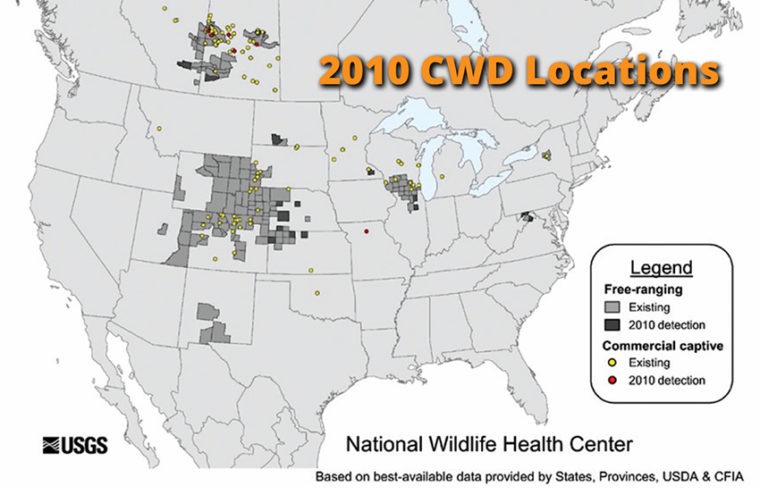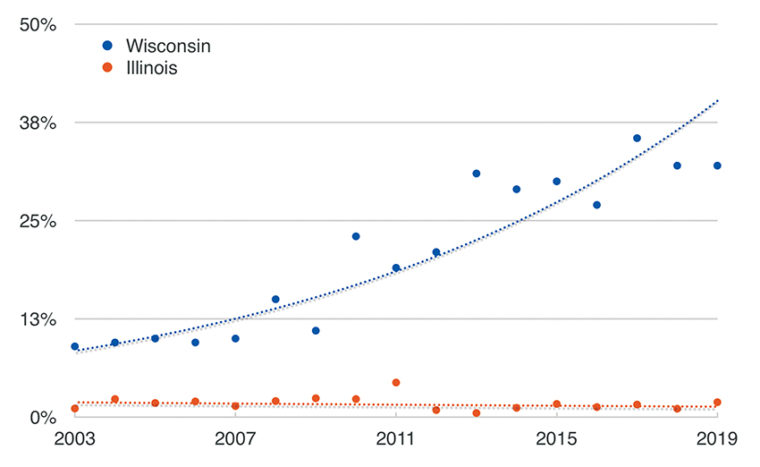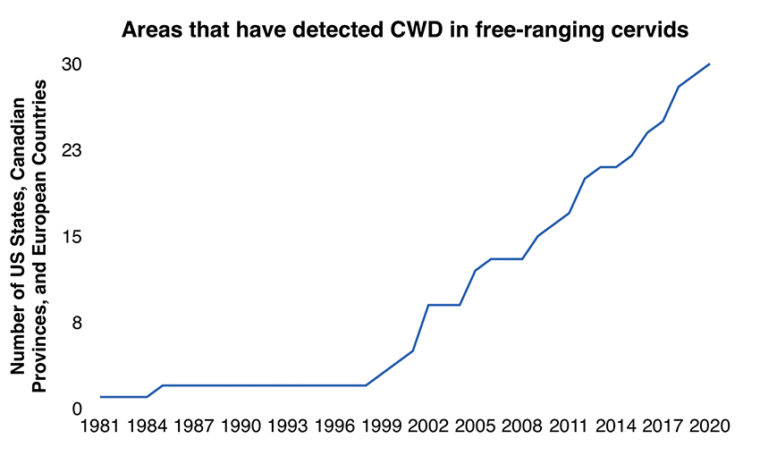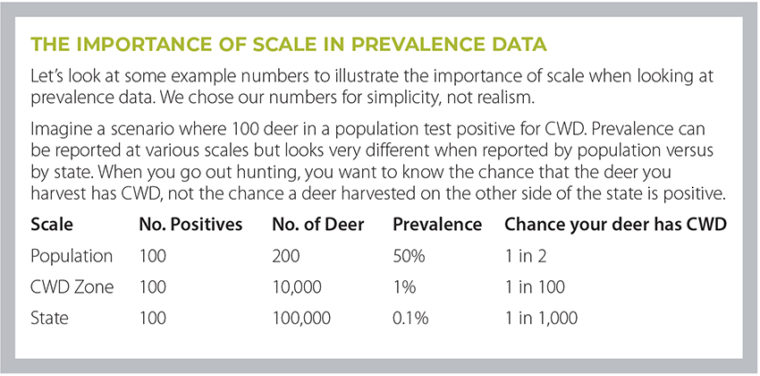One thing 2020 has taught us is that new diseases can change everything. The COVID-19 virus started in wildlife, spread to humans in every corner of the world, caused a massive health crisis, and impacted our workplaces, schools, restaurants and airports. Initial reactions to emerging diseases often are stressful because we lack knowledge and are uncertain of impacts.
Chronic wasting disease (CWD) is now established in free-ranging deer in 43% of states and provinces in the United States and Canada. In the 50-plus years since CWD has been known about in North American deer, we have learned a lot about how managers and hunters can deal with this disease. New research results continue to inform management modifications. We wrote this article to help hunters and landowners across the eastern half of North America better understand CWD and the resulting “new normal” of deer management.
Why You Should Care about CWD
Chronic wasting disease is a hot-button issue among hunters these days, with a lot of information flying around social media. Some of this information is true. Some of the information, well, is not so true. In this article, we will clarify points of confusion about CWD and its management.
As you may know, CWD affects the deer family, including white-tailed deer, mule deer, and elk. It involves a protein that is a normal part of a healthy nervous system in animals, but in a fluke of nature, the protein has become malformed and infectious. A healthy deer will develop the disease if it is exposed to enough of the malformed protein or if it is transferred to the fetus from an infected mother. This infectious version of the protein, called a prion, stimulates production of more malformed proteins within the nervous system of a previously healthy animal. Prions accumulate and ultimately degrade nervous system functions over several months or even years.
Deer deaths from CWD are rarely obvious. Educational information on CWD may include photos of thin, confused-looking deer, but this isn’t the typical CWD-infected deer you will see. While this is the final stage of CWD, the disease is similar to AIDS and COVID-19, in that it increases the risk of death from other causes. Failing nervous system functions cause a loss of awareness, leading to vehicle collisions, being killed by predators, and being more susceptible to hunter harvest. Increased production of saliva and decreasing muscle tone lets saliva enter the lungs, which leads to a greater chance of pneumonia. This means that many deer with CWD will die directly from other causes before they ultimately become the sickly animals used in reference photos.

Wild Deer with CWD rarely appear sick to our eyes. They may carry and spread CWD for up to two years before visible signs appear, and the neurological effects of the disease lead them to be more prone to other causes of death in the meantime. This Wisconsin buck was photographed by NDA member Paul Annear of Wisconsin, who killed the buck not lond after the photo was taken. The buck tested positive for CWD.
Where and when deer die from CWD adds to some of the common misunderstanding over CWD. In contrast to the concentration of dead deer around water sources seen during a late summer/early fall outbreak of hemorrhagic disease, CWD-associated deaths are much less noticeable because deer die throughout the year and carcasses are spread out across the landscape.
These deaths are not a case of “what we don’t know can’t hurt us.” Even though hunters are not as aware of the number of diseased and dying deer, there are population-level impacts. Infected deer generally die at a younger age than uninfected deer, reducing the number of years does can reproduce. Less reproduction may drive population declines at the high disease prevalence levels occurring in areas where CWD has been present longest. For example, studies in Wyoming reported a white-tailed deer population declined by 10% and a mule deer population declined by 20% per year. Studies to clarify population-level impacts in eastern North America are underway in Wisconsin and Arkansas.
What We Know About Transmission
A big point of discussion on social media has been on how CWD spreads between individuals. This, and whether CWD can spread to humans, are topics scientists are still studying, but we know enough to take reasonable actions.
One major goal of CWD management is reducing the spread of the disease since it is so difficult to remove from an area once it arrives – an ounce of prevention is worth a pound of cure! Dispersal of young bucks is a natural source of localized spread (see the information about dispersal above). Human movement of carcasses or live deer has the potential to spread infectious prions much farther and faster than occurs from natural deer movements. The most effective means of spreading a disease is by moving a living disease carrier, as seen during the recent worldwide spread of COVID-19. Passengers flying across the globe in a matter of hours brought along the developing virus and its variants.
Spreading CWD via live deer shipments isn’t as extensive as COVID-19, but there are documented cases of “smoking guns” that showed disease spread from the United States to Canada and Canada to South Korea via live-animal shipments. It’s valid to wonder if these examples are just the “tip of the iceberg.” Any movement of live animals without a sensitive live-animal testing option creates conditions conducive to disease transfer. The numerous, widely separated locations of CWD across eastern North America as of 2010 cannot be explained by natural deer movements.

Back in time to 2010, great distances between some occurrences of CWD at the time strongly suggested that the spread was not due to natural movement of free-ranging deer.
An important part of management is testing to learn where CWD is and how many animals are infected. Testing is especially important for diseases like COVID-19 and CWD because infected humans and animals can be infectious even before they show symptoms. Most state wildlife agencies rely primarily on testing samples from hunter-harvested deer to document infection rates and disease spread. Samples are classified as either positive or “CWD not detected,” and a summary of positives per number of samples tested is called prevalence. These data are important and allow biologists to monitor changes in extent of the disease.
Use and Misuse of Prevalence Data
Just like we’ve seen during the COVID-19 pandemic, prevalence data is complicated and can easily be misinterpreted or mis-represented in social media. The most important statistic is prevalence in the disease zone because it shows how CWD has progressed where it is known to be present. However, prevalence can also be reported on the county or state level. These numbers are easier to report because it can be difficult to define the boundaries of an affected area, and reporting often occurs at government levels like counties and states.
With COVID-19 reporting, you most likely have seen prevalence by country, state, and maybe county. Think back to when COVID-19 was first found in the United States, in a Washington state resident. This positive could have been reported on any scale: city, county, state, country. Though the U.S. was positive for COVID-19, this positive did not yet affect people from other states so it would have been misleading to label all 50 states as positive. The same can be said on the state scale. Though COVID-19 had been found in one county, not all counties were affected at that point.
Another problem with reporting prevalence at the county or state scale is that it is difficult to compare between areas because counties and states vary in acreage and deer populations. Although it’s a convenient scale for sampling, CWD prevalence at larger scales is less informative because it is usually a mix of samples from herds that are affected and those not yet exposed. Prevalence reported by herd or disease area includes only animals currently affected by or at risk from the disease and allows managers to better track how CWD is changing within the known-infected area. Monitoring other areas will allow the managers to document new areas for management, much like how we watched public health managers document spatial changes in COVID-19 across cities, regions, states, and countries. Tracking these changes allows managers to apply actions most appropriate to the circumstances. Claims that CWD is at an extremely low prevalence at the state or national level may be accurate, but they ignore significant disease progression taking place at the population level. A local population decline would barely show up in statewide statistics. The sensitivity of data at smaller scales helps managers see what is really going on.
One management action often used around a disease area is intensive sampling. Agencies may test more samples around an area known to have CWD compared to other areas. The reason for this is that CWD can spread by “sparks” the same way a fire can spread through embers in the air. A yearling buck dispersing 5 to 10 miles to a new area may bring CWD with him. By increasing testing in areas around disease zones, managers increase their chances of catching these “sparks” early—hopefully before they create a new inferno.
Managing CWD
Managing diseases – whether in humans or wild animals – is difficult. Think about all the ways public health officials have tried to lessen the COVID-19 outbreak: mask mandates, testing people for COVID-19, closing public gathering spots, treating and isolating positive cases, rolling out vaccinations, and more. These approaches address different aspects of the pandemic, and they have not been equally effective in all places. The same is true of CWD.
All management actions used with CWD have the goal of reducing the rate of disease spread within the population and out into new populations by slowing the spread of the infectious material. One basic precaution taken by most states is banning the movement of deer and certain deer parts from states with the disease or between areas within the state. This action is designed to prevent the introduction of the infectious material to new populations from routes other than normal deer movements.
Reducing deer-to-deer transfer is very important in the management of this disease. CWD is contagious, so animal-to-animal contact spreads it between individuals. State agencies try to mitigate this through (1) reducing unnatural concentrations of deer and (2) reducing deer density. Banning or restricting the use of bait or feed is commonly used to reduce the chance an infected deer will leave prions that can be picked up by other deer. Higher deer density increases natural interactions among deer, which will increase the frequency of disease transmission, so many state agencies promote increased harvest rate.
When a new infection is identified in an area, some states actively manage the local outbreak using targeted removal, also known as sharp-shooting or culling, with the goals of sampling to refine the actual infection rate, removing infected individuals, and to reduce deer density. Most states that have found CWD in free-ranging deer have used at least some amount of special collections either as a management tool or a way to gather more samples to test. Targeted removal for sample collection is common following an initial detection of CWD, but thereafter is used only when hunters provide an inadequate number of harvested samples.

CWD prevalence in bucks from the disease zones of Illinois and Wisconsin show how the disease progresses differently under different conditions. Wisconsin ended targeted removal by the government in 2007 while Illinois continued their effort. The difference in CWD prevalence between the two states is likely a result of more intensive management in Illinois.
The value of targeted removal of infected individuals and reducing density can be seen by comparing actions and prevalence data in Wisconsin and Illinois. Both states discovered CWD in deer early in the 2000s. Wisconsin applied supplemental, localized culling for six years but stopped due to landowner and political complaints. Illinois followed the same initial approach and has continued using localized, post-season culling to remove deer from areas where they did not have adequate hunter harvest. We’ve expanded results from an often-referenced paper by the University of Illinois that showed how the prevalence of CWD-infected bucks held steady at 1 to 3% prevalence in the management zone in Illinois but increased up to 50% in the management zone in Wisconsin after targeted removal was stopped due to political pressures.
Importantly, the researchers found that culling did not affect the annual number of hunter-harvested deer. Illinois’ success comes from hard work by the DNR with the support and help of its citizens. Minimizing spread within a population and across an area are the only reasonable management expectations once an infection is established.
Complete eradication of CWD is rare because it is essentially impossible to eliminate CWD once it’s established in a free-ranging population. Agencies typically don’t find the first infected deer, rather this slow-developing disease typically spreads within a population prior to its discovery. New York state is unique in that it is the only governmental entity to apparently eliminate CWD from free-ranging deer. Their success was due to effective cooperation between the Department of Environmental Conservation and the captive deer industry. When five captive deer tested positive for CWD, the wildlife agency quickly implemented a cull and test program and found two positives within free-ranging deer near the facility. New York has not detected any new cases of CWD, despite testing over 7,000 deer from within the 10-mile containment area during the following five years.

The number of US states, Canadian provinces, and European countries detecting CWD in free-ranging deer is increasing. Federal funding in 2002 allowed many states to start or increase CWD testing which led to a spike in states positive for CWD. Had that funding not occurred, CWD may not have been detected as quickly in these states, and management responses would have been delayed.
Managing for CWD is expensive and time consuming for agencies, but there are ways that concerned hunters can help. Adequate sampling is crucial for agencies to determine the prevalence and distribution of CWD. Sampling hunter-harvested deer is the cheapest and least labor-intensive option for a wildlife agency. However, when necessary sampling goals are not met by this alone, agencies may have to use more labor-intensive methods like sampling road kills and localized targeted removal to fill in the gap.
The Scientific Process, and What’s Next
It is easy to be frustrated by the lack of concrete information about new diseases, but it is important to understand that good science takes time and funding. Just like we’ve continued to learn more and more about COVID-19 every day, new research about CWD is always emerging. Outside factors can help continue and quicken this. For example, increased federal funding for CWD testing in 2002 led to a spike in detections that may not have occurred without the funding. The same is true for all facets of CWD. Testing, management, and research require public support and governmental funding.
As we wait for more information, it is important to use what is already known. For example, the progression of CWD in the states where it first occurred suggests how it may play out in states where it has newly arrived. The information learned from these past outbreaks is used by researchers to build models that show possible futures with and without specific management actions. Modelling can also be used to identify which variables are important in the spread of CWD and how it affects different areas. While these models are not perfect, they are helpful tools in understanding and fighting CWD.

You can join the fight against CWD in many ways, like submitting deer for testing if you hunt in a CWD zone, and transporting only boned-out venison and other approved parts across county or state lines.
New research increases our understanding of this groundbreaking disease. This research is usually publicly funded, so it needs public support. Tell your elected representatives you want CWD research funded and testing expanded. If you’re a hunter in a state where CWD has been found, help your state wildlife agency learn how CWD is spreading by dropping off samples for testing.
To gather more information and manage against CWD as effectively as possible, everyone must work together; hunters, captive deer facilities, state agencies, and politicians all have a role to play in fighting CWD. It is crucial to collaborate and learn from one another how best to minimize the impact of this disease on deer populations and our recreational enjoyment of them.
About the Authors: Miranda Huang is a graduate student in the Deer Ecology and Management Lab at Mississippi State University (MSU Deer Lab). Dr. Steve Demarais is a wildlife biologist and professor, and Dr. Bronson Strickland is an extension wildlife specialist and researcher, both also at the MSU Deer Lab / Instagram: @msudeerlab


